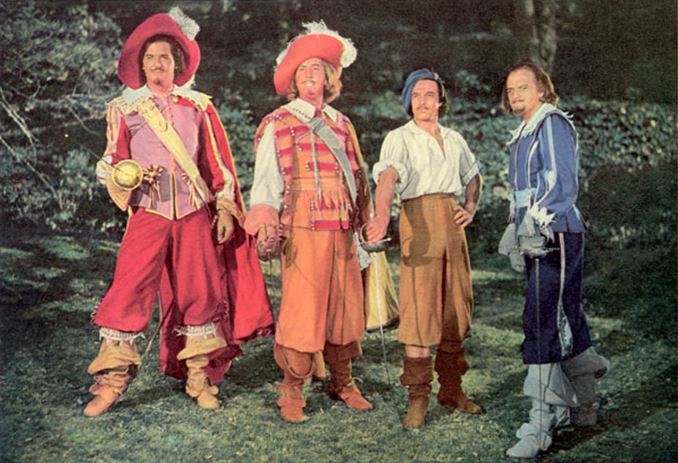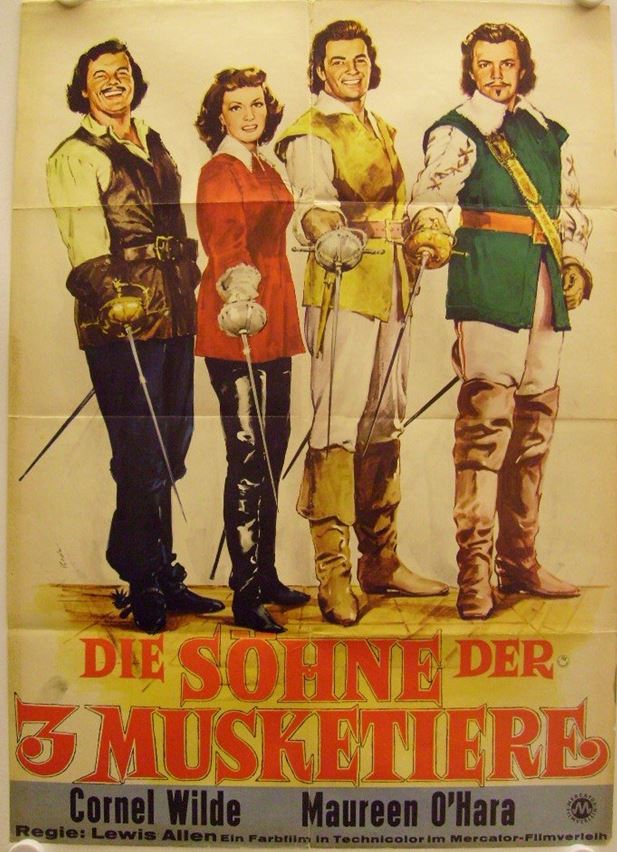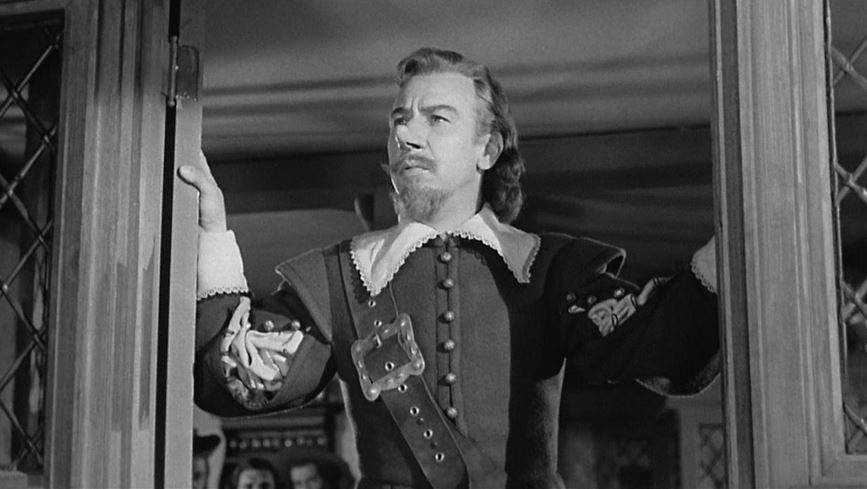Ellsworth’s Cinema of Swords: 3 Musketeers + 1 Long Nose
The Three Musketeers (1948)
When you say “French swashbuckler,” two names leap instantly to mind: d’Artagnan and Cyrano. Both were actual historical figures, but it’s through their fictional incarnations that they’re known around the world. Both d’Artagnan and Cyrano de Bergerac have been fictionalized repeatedly dating back to the 17th century — zut alors, Cyrano even fictionalized himself! — but they’re overwhelmingly best known from two sources, d’Artagnan from Alexander Dumas’s The Three Musketeers and it sequels, and Cyrano de Bergerac from Edmond Rostand’s play of the same name. There have been several memorable screen versions of Rostand’s Cyrano, but none more so than the version reviewed below. The Three Musketeers, of course, is one of the greatest adventure novels ever written, and has been filmed for movies and TV dozens of times, with varying degrees of quality and fidelity to the source material. This week we’re looking at one of the best, and throwing in an oft-overlooked sequel as a bonus.
The Three Musketeers
Rating: *****
Origin: USA, 1948
Director: George Sidney
Source: Warner Bros. DVD
There were a lot of movie and TV adaptations of The Three Musketeers in the 20th century, but three of them tower above all the others: the Fairbanks film from 1921, Richard Lester’s 1973 version, and, falling almost exactly in between them, MGM’s star-studded entry from 1948.
This is an interesting adaptation: it starts out as a typical Hollywood vehicle for star Gene Kelly, bright, colorful, charming, and light-hearted, a musical without songs, as d’Artagnan (Kelly) finds camaraderie with the musketeers and romance with Constance (June Allyson). But the top-billed actor at the time was actually Lana Turner, then at the height of her fame, and based on her roles as a femme fatale in films noir, she was cast as the wicked Milady de Winter. Now Milady appears mostly in the second half of Dumas’s novel, so to give Turner enough screen time, the movie races through the Affair of the Diamond Studs in its first hour, enabling it to spend its second hour on the schemes of Milady.
These schemes take the story into darker places than most screen versions of T3M, and toward the end the tone turns quite grim. The emphasis on Milady also explains the elevation of Athos (Van Heflin), her bitter estranged husband, nearly to the level of co-protagonist with d’Artagnan. Heflin, an actor of stature and gravitas, ranks up there with Oliver Reed for Best Athos Ever, but Turner doesn’t seem entirely engaged with the part of Milady — though when she does get into it, it works.
One thing the aforementioned best versions of T3M all have in common is a recognition that the novel is not only full of adventure, intrigue, and romance, it’s also funny as hell. The humor in the MGM version is mainly delivered by Kelly, who puts in a broad and unrestrained performance, adopting some of the exaggerated silent-film mannerisms of Douglas Fairbanks, Sr., as well as all of his athleticism. Kelly even goes Fairbanks one better, because he’s not just an acrobat, he’s a dancer, and his swordplay owes as much to the school of ballet as it does to the academy of arms. Of course, at age thirty-five, Kelly was too old for the part of d’Artagnan, but that’s true of every screen incarnation until Michael York took the role in ’73, and Kelly makes up for it with energy and dexterity. All the fencing in the film is with slender foils rather than period rapiers, but the swordplay, Kelly’s especially, is more theatrical than realistic: it’s choreographed to the split-second and very entertaining indeed.
And we must note that in addition to Turner and Heflin, Kelly is backed up by a top cast. On the male side, we get Frank Morgan (the Wizard from Oz) waffling adorably as the ineffectual King Louis XIII, and sly, malicious Vincent Price gives us the best Cardinal Richelieu since Raymond Massey’s turn a decade earlier. On the female side, Angela Lansbury is perfect as Queen Anne, while June Allyson gives Constance more depth than the character usually gets. (As is usual in a Hollywood T3M, Constance is single here, goddaughter to the landlord Bonacieux, rather than his wife.)
Playwright Robert Ardrey’s script is very good, tight and fast-moving without ever feeling rushed, and includes the inspired idea of giving Constance the role of jailer-in-chief when Milady is imprisoned in England, a vast improvement over the weak coincidence that throws them together in the novel. We get some scenes from the book that are rarely filmed; for once all four of the musketeers’ lackeys make an appearance, though only Planchet (Keenan Wynn) gets any lines, and even minor villain the Count de Wardes shows up, mainly so d’Artagnan can impersonate him later. The ending, as alluded to earlier, is dark, but Richelieu’s revenge on d’Artagnan is forestalled by the famous carte blanche: “It is by my order, and for the good of the State, that the bearer has done what has been done.” Exactement.
At Sword’s Point
Rating: ****
Origin: USA, 1952
Director: Lewis Allen
Source: Warner Bros. DVD
This sequel to The Three Musketeers was made by RKO a couple of years earlier but not released until 1952, possibly to get it out of the long shadow of the 1948 MGM version. There have been dozens of screen versions of The Three Musketeers, but Hollywood has never quite figured out how to adapt Dumas’s sequel, Twenty Years After, into a successful film. This story uses some of the elements of that novel, in particular France on the verge of civil war after the deaths of Louis XIII and Richelieu, as the aging Queen Anne tries to preserve order until Louis XIV can come of age, while the fractious nobles, personified here by the scheming Duke de Lavalle (Robert Douglas) vie to seize power.
However, instead of having the novel’s older versions of the four musketeers step in to sort things out, this tale calls on their grown-up children to rise to the occasion. Could this be Hollywood ageism at work? Well, it certainly isn’t sexism, because one of the younger generation is Athos’s daughter Claire (Maureen O’Hara), and she’s as good with a blade of any of the men — with the possible exception of the younger d’Artagnan, who’s played by an Olympic fencer (Cornel Wilde).
Let’s get right to the point: this is the first serious movie representation of a female swashbuckler who is the equal of the men — and accepted by them as such! There’s still plenty of flirtation toward Claire by the young Aramis and d’Artagnan — I mean, these are musketeers — but it’s not condescending, and she gives as good as she gets. The people who underestimate Claire are the villains, and they learn to be sorry they did. The best moment in the picture is when Lavalle, who’s strong-armed the queen into letting him marry Princess Henriette, leads her to the altar, lifts her veil, and finds that Claire has taken his bride’s place and the princess is safely in the hands of the other musketeers. And Claire, faced with the wrath of the most powerful man in France, just laughs in his face!
The plot here is nothing to write home about, being the usual series of swordfights, kidnappings, escapes, pursuits, betrayals, traps, and rescues, but the writers were clearly admirers of Dumas, and there are a number of fun call-outs to the novels, e.g., minor characters named Planchet and Rochefort, and at one point Claire, hoodwinking some guards, assumes the name Countess de La Fère—the family name of her father, Athos. Plus, the costumes are better than average, Wilde does some nicely acrobatic swashbuckling, and the familiar blue tabards of the King’s Musketeers come out of the wardrobe for the grand finale. All good stuff, but it’s still Maureen O’Hara who walks away with the prize for this film.
Cyrano de Bergerac
Rating: ***** (Essential)
Origin: USA, 1950
Director: Michael Gordon
Source: Alpha Video DVD
You’ve seen this, of course, probably more than once. If you haven’t smile, nod, and pretend you have, then tonight make the time to find it and watch it. It’s based on the 1897 play by French poet and playwright Edmond Rostand, who wrote the original entirely in verse, in rhymed couplets. The play was a gigantic hit that ran for years and toured the world. In 1923 prominent American stage actor Walter Hampden commissioned the New York poet and playwright Brian Hooker to create an English translation in blank verse that became the standard English translation for the next half-century; Hampden, playing Cyrano, used it in touring productions throughout the 1920s and ‘30s. (Fun fact: as good as the Hooker version of Cyrano is — and it’s very, very good — there’s another fine English version that appeared in 1970 from none other than Anthony Burgess, the author of A Clockwork Orange.)
The brilliant Puerto Rican actor José Ferrer revived the play on Broadway in 1946, winning a Tony award, reprised the role for a live TV production in 1949, and then again for this movie version in 1950, for which he took home the Oscar for Best Actor. The movie was an independent Stanley Kramer production, made on the cheap, and it’s been criticized for its low production values in an era of grand Hollywood epics, but really it looks fine and frankly its approach suits the material, opening out just enough from the staginess of the play to avoid theatrical claustrophobia.
By the time he made the movie version, Ferrer had been playing the role of Cyrano for years, and really came to inhabit the part. He loved it, and his enthusiasm is infectious to this day. The play was shortened somewhat to fit a feature’s run-time, with some new interstitial material written by Orson Welles (uncredited) to mask the transitions between acts; this included a brief scene between the Comte de Guiche (Ralph Clanton) and his uncle “The Cardinal,” who though unnamed is clearly intended to be Richelieu. Also added to the film were the swordfight with the “hundred” thugs and the combat with the Spanish at the Siege of Arras.
For a low-budget production these battles were well done, but this should come as no surprise considering the film’s fight director was the veteran sword-master Fred Cavens, who coached the fencing in just about every Hollywood swashbuckler from the silent era on. (Get this: Cavens coached Douglas Fairbanks, Sr., as Zorro in 1921, Tyrone Power as Zorro in 1940, and Guy Williams as Zorro in 1957!) Ferrer holds his own in these fights, and looks good doing it — and you can tell it’s him and not a double, because who else would have such a big nose?
The previous installments in the Cinema of Swords are:
Olivia de Havilland — First Queen of the Swashbucklers
Goofballs in Harem Pants
Disney’s Early Swashbucklers
‘50s Vikings – Havoc in Horned Helms
Laughing Cavaliers
Charming and Dangerous: Douglas Fairbanks, Jr.
Eleven Samurai: Early Chambara Classics
Beyond Captain Blood: Three by Sabatini
LAWRENCE ELLSWORTH is deep in his current mega-project, editing and translating new, contemporary English editions of all the works in Alexandre Dumas’s Musketeers Cycle, with the fourth volume Blood Royal, just published by Pegasus Books in the US and UK. His website is Swashbucklingadventure.net.
Ellsworth’s secret identity is game designer LAWRENCE SCHICK, who’s been designing role-playing games since the 1970s. He now lives in Dublin, Ireland where he is co-designing a new mobile RPG for the WarDucks game studio.



Thank you, Mr. Ellsworth, for another sterling entry in your Cinema of Swords. All three films are immensely entertaining, but I must agree with your rating of Cyrano de Bergerac; it is just a great movie.
I do like At Sword’s Point; it was while watching this film 50 years ago, that I realized I was in love with Maureen O’Hara. Sigh.
Great stuff! These columns are a blast.
At Sword’s Point is new to me–definitely something I’ll have to track down. Maureen O’Hara with a sword! Wish someone had told me about this decades ago. (Or I’d listened when they did.)
Cyrano is a big deal to me–whether we’re talking about the play, the movie, or the weirdo 17th-C sf writer. I agree the Ferrer version is a classic and a must-see. I wish somehow it had had a decent remake in the last 70 years, though. There was a French version about 30 years ago with Depardieu playing the swashbuckling poet. It has a lot going for it, but I remember being a little disappointed in the verbal give-and-take, especially in the pivotal “I have just arrived from the moon!” scene.
I was surprised at how much I liked the 1948 version of Three Musketeers. I was already a huge fan of the Richard Lester Three Musketeers/Four Musketeers. But the ’48 version is super-fun, and Kelly’s lighthearted physicality made him perfect for the role.